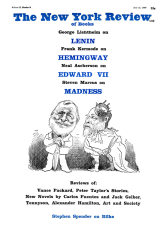The more New York becomes a problem to itself the less good old self-sufficient exuberance can be expected from novels that restrict themselves to the city. Which is no less true of its art. The more seemingly naive a work by Johns or Rauschenberg the longer and subtler a commentary it appears to need; and when commentary fails, a mere narrative of how the work was, and could only have been, done in New York (Lippold’s sculpture in the lobby of Lincoln Center or Tingueley’s self-immolation machine at the Modern Art) takes on all the metaphysical aura of Gesamtkritik.
Some years after his precocious success at the Living Theater with The Connection, a play whose gloomy, goodnatured O’Neillish substance was frosted over with Pirandellian gimmickry, Jack Gelber has written a novel that uses the conventions of pop art much as the play used absurdist theater, but with more skill, to make an orthodox old-fashioned naturalist more palatable to the sophisticated. What might pop art in fiction be? First, of course, a strenuous allegiance to plain descriptive realism; secondly, an apparently random but archtypical choice of events and objects, systematically foreshortened, brought to the front of the “canvas”; thirdly, a deadpan “boyish” humor in which exasperation is balanced as evenly as possible by full-bodied substance; fourthly, a “serial” technique in which objects and episodes comment on each other by being part of the same unglamorous world, at about the same level of non-sophistication, instead of a reliance on inner symbolic relations to different social and psychological levels of life; fifthly, the isolation of “philosophizing” into discrete blocks apart from the “work.” It matters little whether the artist’s friends or the artist himself supplies the commentary; the soliloquies of Gelber’s hero or Rauschenberg’s tireless gallery talks at his own shows.
Pop art, worthy as it certainly is, seems to me as an American a special feature of the New York Problematik, conceivable only under the exasperated conditions of a painter’s life in contemporary Manhattan. But I’ve read at least one wildly enthusiastic review of Rauschenberg in the British press, so am unwilling to predict how Gelber’s thoroughly New York novel may export. It will tell you nothing new about Bohemia, no titillating revelations, no fanciful erotica. The Cro-Magnon vocabulary is predictably flourished, but subdued, diluted by a good deal of ordinary English. Nothing illustrates better the reforming puritanism of the city’s latest phase than the accuracy of Gelber’s hero, Manny Fells, a twenty-six year old Jew from Springfield, Illinois, as a mirror of the general homogenization of uptown and downtown attitudes towards commerce, sex, art, freedom and decency. In this respect he reaches a transcontinental hand to the late Raymond Chandler, creator of Philip Marlowe, private eye, redeemer on his own battered, absorbent person of the intricate corruptions of a vanished, highliving Los Angeles.
Humphrey Bogart played Marlowe in The Big Sleep; like Bogart, whose Fifth Avenue-Exeter-Yale provenance stuck out all over him, Manny Fells is no true underground man but one of nature’s uncles, always “concerned” in a Quakerish way and always wincing, stoic and temporizing, playing for money and time, much less sheerly committed than the earlier Raskolnikovs of New York fiction. Conscientious, gloomy, irritable, gallantly sexy; ridden with headaches, cockroaches in his loft, parents on the long-distance phone, creeps and cripples smoking pot and raising hell when he needs sleep, a sucker for hard-luck cases, Manny has reached the point where a decent uptown job looks like mecca. On Ice is probably the first novel to document the rites of passage from beatnikdom through the shady lower levels of commerce (at first Manny takes a job as a company spy in a big department store in a shopping center, commuting in a borrowed car that gives him no end of trouble) to a semi-creative uptown job as a company photographer (private eye, so to speak). Gelber’s man is moved not by cynical hucksterism, not at this point anyway, but by the universal New York rage for space, light, movement and cleanliness, not to mention a good night’s sleep.
The Connection gave us a homoerotic nirvana in the last stages of catatonia. On Ice embraces the female element in the form of an amusingly well-projected young woman, Louise, of the type who spends her first night cleaning one’s loft, her second day painting the walls; in other words an embryo uptown “artistic” wife, a nagger-to-be but also Manny Fells’s fated helpmeet in the climb from Gehenna.
As technique and sociology, then, On Ice has considerable interest. Gelber’s super-cooled naturalism protects him from the outworn commonplaces of romantic hipsterism, with which he is well acquainted, without sacrificing some of the humor, bounce, and charm that will always be part of the life. Lacking the gift to render the geniuses and demigeniuses who still inhabit those regions in the light in which they see themselves—a task for a Balzac—Gelber has done the next best thing by enlisting their spirit in the city’s nonsectarian cry of disgust. And thereby given comfort to us yokels long conditioned to think this way, by prophets ranging from James Baldwin to Jacques Barzun.
Advertisement
This Issue
June 11, 1964



